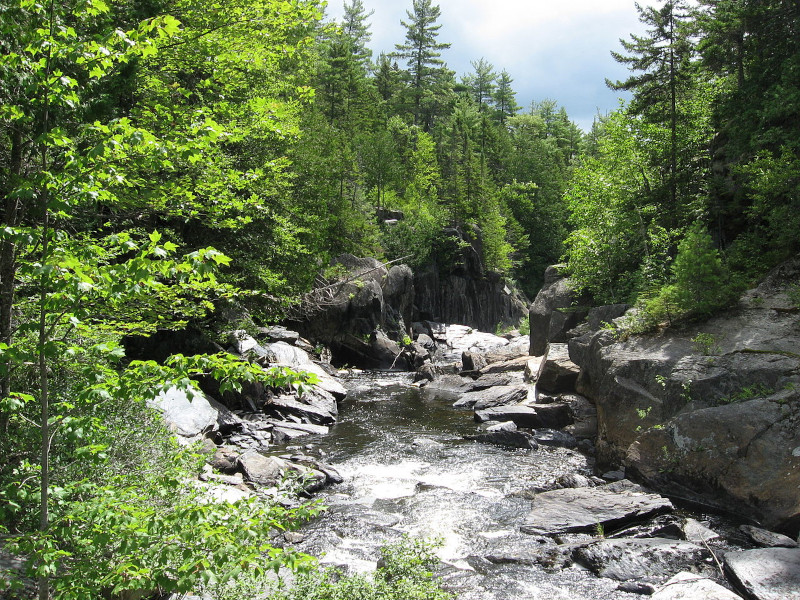Gulf Hagas Facts
- This remote, ruggedly beautiful, yet little-known, marvel of geological processes bears the somewhat deceptive name of Gulf Hagas. It’s quite obviously not a gulf, but is in fact a magnificent gorge cut through the surrounding terrain over a vast span of time.
- It’s not known when the first European settler in the region discovered this amazing site. The local Native American tribes, however, long knew of its existence. That’s because archaeological evidence of their presence dates back as much as 7,500 years.
- In modern times, though, the location constitutes one of 14 National Natural Landmarks in the region in which it formed. It thus represents a popular, if difficult to access, tourist area. It’s open to the public, for a fee, during the regular season.
- It also forms part of the incredible Appalachian Trail, which extends a total of 2,200 mi (3,500 km). In point of fact, the section in which it lies forms the last 100 mi (160 km) of the magnificent trail. It’s also considered by many to be the most remote portion.
- The opportunities for hiking therefore obviously form a primary appeal to visitors to Gulf Hagas. Its pure scenic beauty, however, also attracts many viewers. Other popular attractions to the site include kayaking its waters, though only for experts, and fishing.
Related Articles
Gulf Hagas Physical Description
The stunning Gulf Hagas quickly earns the appreciation of those fortunate enough to visit its location. That holds true due to numerous attributes, of course. Though it’s by no means the largest such feature on earth, it nonetheless boasts some respectable dimensions.
The beautiful gorge possesses a total length measuring approximately 3 mi (4.8 km). Much of that, though, holds a twisting, winding nature. While its walls naturally vary in height across its length, these reach a maximum height of 130 ft (40 m) in some locations.
A branch of the Pleasant River also flows through its length. Between it sheer vertical walls, the course of the river flows over a highly rocky bed. Numerous regions of rapids also appear along its length. Numerous small but lovely waterfalls also dot its course.
Along its length, though, the river also drops relatively significantly. More precisely, its elevation drops a total of 370 ft (110 m). Due to this comparatively steep decline, the flow becomes quite strong in some regions, creating the powerful rapids for which its known.
The width of the remarkable Gulf Hagas also, quite naturally, varies along its entire length. This variation becomes extreme in some places. In some sections, it attains a width of as much as 150 ft (45.7 m). In others, however, it narrows to as little as 26 ft (7.9 m).
Gulf Hagas Location, Formation, and Ecology
The astonishing beauty of Gulf Hagas formed in a region of the globe already well known for its abundance of geological marvels. That’s because this visually tantalizing work of Nature formed on the region that now constitutes the continent of North America.
More precisely, though, the gorge formed in the region that now comprises the state of Maine, in the United States. There, it further, and purely by coincidence, lies in the approximate middle of the state. It also lies about 90 mi (140 km) from the city of Bangor.
The section of the Appalachian Trail this wonder lies in also happens to bear the name of the Hundred-Mile Wilderness. It formed 400 million years ago. That occurred due to the convergence of tectonic plates. It’s part of what geologits call the Carrabassett formation.
Mud deposits slowly crystallized into the mineral slate. This now comprises the majority of the bedrock in its region. This mineral created angular edges when fractured, but wind erosion later smoothed these out. This further shows in the nature of the canyon walls.
Flora and fauna both abound within the confines of Gulf Hagas. In fact, its course wends its way through one of the last remaining virgin old growth forests in the region. Enormous eastern white pines line its course, some reaching as much as 150 ft (46 m) in height.
Many animal and insect species makes their homes within these forests, among the accompanying spruce and fir trees. Along with the usual small animals native to the region, such as the snowshoe hare, larger mammals such as various deer and elk also call it home.
Features Sharing Its Region
Check out our other articles on 3 Particularly Precious Parrots, Indo-Pacific humpback dolphin, Atacama Desert, Hemlock Looper, Jewelled Gecko, 5 Geological Wonders of Australia

